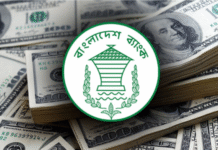 Bangladesh crossed two foreign reserve benchmarks in the last two months but the World Bank says it should be increased further to provide a cushion against risks.
Bangladesh crossed two foreign reserve benchmarks in the last two months but the World Bank says it should be increased further to provide a cushion against risks.
“Source of risk for a country like Bangladesh would include external liabilities as well as current account variables and some measure of potential capital flight. Export earnings reflect the potential loss that could arise from a drop in external demand or terms of trade shock,” according to a WB report — Bangladesh Development Update — released on Wednesday.
A Bangladesh Bank official said despite these risks, huge investment is being made in both the public and private sectors.
The country’s foreign currency reserves crossed $17 billion on October 22; it crossed $16 billion last month. The quick increase in foreign exchange has put the central bank in a tricky position in ensuring that the taka does not appreciate more against the dollar, which will adversely affect exporters and expatriates.
According to traditional concepts, maintaining a country’s foreign exchange reserve to cover three months’ import bills is sufficient.
But Bangladesh’s latest forex reserve is sufficient to cover import bills for six months.
In this context, the question arose over an excessive reserve.
The WB report said, “The rapid increase in reserves in recent months raises the question of whether this accumulation has been excessive.”
“The ongoing currency volatility in India, Indonesia, Brazil, and Turkey has again demonstrated the importance of holding adequate reserve as part of the country’s defence against shocks, while working on structural vulnerabilities in a credible manner.”
The WB report said most countries, regardless of the region, have accumulated more reserves in recent years than suggested by standard rules of thumb. The median coverage ratios among emerging markets are around 6 months of import, 200 percent of short term debt and 30 percent of broad money.
In most low-income countries, the median coverage ratios are around 4.7 months of imports, 55 percent of broad money and 20 percent of GDP, it said.
The report, however, said Bangladesh’s current reserve level constitutes 4.6 months of import cover, 11.8 percent of GDP and 20.1 percent of broad money.
In the present context, Bangladesh’s foreign exchange reserve is not excessive, Zahid Hussain, lead economist at the WB Dhaka office, said on Wednesday.
Bangladesh Institute of Development Studies’ Senior Research Fellow Zaid Bakht said it is not a question of whether the forex reserve in Bangladesh is excessive or not. He said the matter of concern is that the country’s imports are falling and investment is not increasing. Due to exchange rate volatility, exporters and remitters are being affected, which is not desirable, Bakht added.
The central bank official said the foreign currency reserve has increased but they feel it should be more.
In recent times, investment is low but once the political uncertainty is over following the next national elections, investment will pick up, the official added.
The government has taken an initiative to build the Padma Bridge with its own funds, along with some other big projects like the metro rail and Dhaka Elevated Expressway, which will require huge amounts of foreign currency, the official said.
Last fiscal year, the central bank approved foreign currency loans worth around $1.8 billion; repayment of the loan will also require foreign currency, the BB official added.
Considering the overall demands from the economy, the current reserve is comfortable, but it needs to the increased, he said.
Source: The Daily Star









